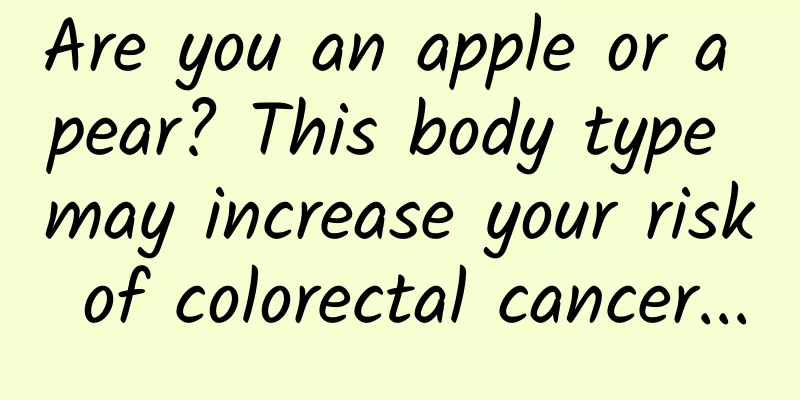Are you an apple or a pear? This body type may increase your risk of colorectal cancer...

|
Compiled by: Gong Zixin Colorectal cancer is the third most common cancer and the second leading cause of cancer death worldwide, with more than 1.9 million cases and nearly 1 million deaths in 2020. Evidence suggests that people who are overweight or obese (BMI ≥ 25 kg/m²) are at higher risk of colorectal cancer. Waist circumference, hip circumference, and waist-to-hip ratio represent surrogate markers of body fat distribution and, similar to BMI, have been shown to be associated with colorectal cancer risk but do not provide additional insights into colorectal cancer etiology or risk discrimination. Joint consideration of these anthropometric characteristics could provide information on the role of body size in cancer development and further understand how obesity subtypes are associated with differential colorectal cancer risk. Recently, a large international medical research team evaluated the body shape and genetic predisposition of tens of thousands of people to understand the risk of colorectal cancer. The results found that people with ordinary obesity and tall "apple" shaped bodies are more likely to develop colorectal cancer than people with other body shapes. The study was published in the journal Science Advances. In 2016, a group of researchers proposed a promising method for defining body size that could provide insights into the role of body size in the development of colorectal cancer. The method was derived from data from 170,000 individuals of European ancestry and was based on principal component analysis of six anthropometric traits (BMI, weight, height, waist circumference, hip circumference, and waist-to-hip ratio). In observational analyses, two distinct and orthogonal body types, characterizing general obesity and tall central obesity, were both strongly positively associated with colorectal cancer risk. These preliminary findings need to be replicated in different study populations and their potential causal basis evaluated. In addition, the development of colorectal cancer is characterized by various genetic and molecular changes, and body type may play a role through this unique but currently unknown molecular pathway. To this end, in this new study, the research team conducted a similar study in a larger population.
The study, the largest of its kind to date, involved collecting and studying data from 550,000 adults recorded in the UK Biobank. It also looked at genetic data from tissue samples collected from a further 800 donors. The research team found that tall people with an "apple" shape are more likely to develop colorectal cancer than people with other genetically encoded body types. An "apple" shape means that their genes tend to increase weight around the waist. The research team also found that tall, apple-shaped people tend to have more health problems related to the digestive system. In addition, ordinary obese people who are prone to becoming obese due to unhealthy diets are also more likely to develop colorectal cancer. The researchers noted that a generally obese body type was associated with gene expression patterns in tissues with a high proportion of neural cells, while a tall, centrally obese body type was associated with gene expression patterns in mesenchymal cells. This suggests that these two different body types may act through different downstream molecular pathways, which in turn affect colorectal cancer risk. The cover image and images within this article are from the copyright gallery (or copyright holder). Any reproduction or use may lead to copyright disputes. |
>>: Who can resist a bird that can “speak human language” and “play golf”!
Recommend
How to eat pine pollen
With the improvement of living standards, many pe...
The efficacy and function of wild wormwood
There are two types of mugwort. One is domestic m...
Before drawing a book worth 76.23 million, he... went bankrupt first?
In the autumn of 1813, a young man named John Jam...
The efficacy and function of white leaves
The traditional Chinese medicine Baiyebufan is a ...
The efficacy and function of grape leaf begonia
Grape leaf begonia is a kind of traditional Chine...
What Chinese medicine is effective for nourishing the kidneys?
In fact, the effect of nourishing the kidney by t...
Drinking tea incorrectly can harm your health! These 3 types of people should drink less
The habit of drinking tea It seems to be engraved...
Scutellaria baicalensis root extract benefits
In our lives, Scutellaria baicalensis is a common...
The transmission chain of the Xi'an epidemic has increased to 242 cases! 6 places have been linked. How did the epidemic spill over?
On the morning of December 23, Yuncheng, Shanxi r...
The Science of New Year’s Goods | Fuqiang flour, wheat core flour, snowflake flour... Which type of pasta is suitable for making?
|| || Compiled by New Media Editor Li Yunfeng Nor...
The effects and functions of spitting fireworks
For many Chinese people, traditional Chinese medi...
What are the taboos of Tianma Shouwu
Tianma Shouwu is a medicine, which is generally a...
Human-shaped Polygonum multiflorum
Polygonum multiflorum is a perennial vine plant b...
The efficacy and function of round-leaved motherwort
Round-leaved motherwort is a kind of traditional ...
The efficacy of deer bite grass
You may not have heard of the medicinal herb Deer...









